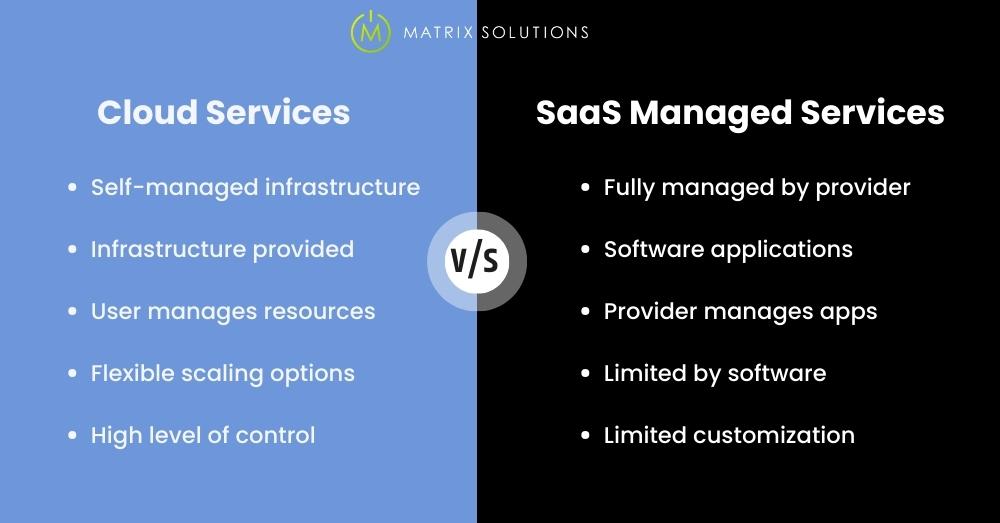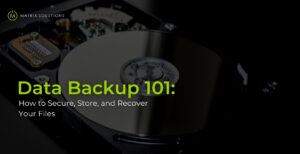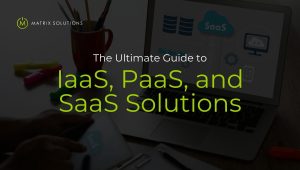Cloud services and Software as a Service managed services (SaaS) are related but distinct concepts in the domain of IT and cloud computing. Here, we provide an overview of Cloud services vs. SaaS Managed Services with the key differences. When you have completely read this blog, you can make the best choice for your organisation.
Both of the services enable the handling of complex technical infrastructure without the additional cost of upkeep and installation, on-call staff, and software engineering.
What Are Cloud Services?
Cloud services are online services that enable you to send and receive emails, edit and store documents, listen to music, play games, and store images. Furthermore, these services include server management, hardware and software management, monitoring, and system intelligence management.
There are various cloud service providers like Google Cloud Platform (GCP), Amazon Web Services (AWS), Microsoft Azure, NetDocuments and Salesforce’s CRM that offer cloud computing services.
Benefits of Cloud Computing:
- Robust infrastructure
- Customisable services
- Easy integration
- Pay-per-service
What Are SaaS Managed Services?
SaaS managed services are the online version of a managed service provider (MSP). They focus on picking your own cloud-hosted tools from the internet, rather than hiring an agency that provides the necessary software tools for you.
SaaS applications are fully managed and accessed through web browsers or dedicated applications. They do not have a specific category of cloud computing that focuses on delivering software applications over the internet on a subscription basis.
Main Differences Between Cloud Services Vs. SaaS Managed services
Cloud services are broadly categorised into on-demand and infrastructure. They are hosted and provided over the internet by cloud service providers. On the other hand, SaaS managed service is a specific category of cloud computing that focuses on delivering software applications over the internet on a subscription basis. It can be considered an iteration of the traditional managed service provider.
In this discussion, we will explore the main differences between cloud services and SaaS managed services, including cost, services offered, security, stability and predictability, scalability, availability, and accessibility.
Availability and Accessibility
Cloud services: Cloud services are available based on configuration and redundancy chosen by the user. You can access it from anywhere with an internet connection. You require a valid license for user support.
SaaS managed services: A SaaS service provider typically has high availability, providing near-constant availability. Users can access the services from anywhere with an internet connection. We provide 24/7 support, ensuring that services are available day and night, including weekends and holidays.
Scalability
Cloud services: Users can scale up or down resources based on their flexibility to accommodate changing workloads. You can add or remove a set of components based on the requirements.
SaaS managed services: Your managed service provider scales up or down resources according to the needs of your business. In comparison to a cloud service, you do not have as much authority.
As the business grows, resources must be organised accordingly. Changes are vital to any business, and they must be both scalable and flexible.
Stability and Predictability
Cloud services: Stability refers to the reliability and consistency of cloud resources and services. Some of the factors that contribute to stability include uptime, redundancy, security, and performance.
Predictability refers to how well user can anticipate and plan for the costs, performance, and behaviour of their cloud-based system. Predictability is lower as compared to SaaS.
Some of the pricing models of cloud computing:
- Pay-as-you-go
- Reserved instances
- Fixed-rate subscription
SaaS managed services: This service provides high stability and predictable performance because the provider manages the application environment. MSPs have IT experts to manage the system optimally.
Security
Cloud services: You must manage the security of your applications and data. Only you and your cloud service provider share the security responsibility.
SaaS managed services: Your managed service provider is solely responsible for securing the application and data, reducing the security burden on you. The agency proactively monitors and creates relevant reports to inform the organisation about the state of its system.
Additional benefits
- Compliance assistance
- Risk assessment
- Correlation analysis
Services Offered
Cloud services: It offers a wide range of services, including infrastructure resources, virtual machines, databases, storage, and networking. Users have the flexibility to build and manage their own applications.
SaaS managed services: In this type of service, your service provider will offer fully managed software applications. These services include sales management, customer relationship management, email, financial management, billing, and collaboration.
The Costs
Cloud services: Costs of cloud services vary depending on usage, commonly following a pay-as-you-go model. You only pay for the resources you consume, which can be cost-effective for businesses with fluctuating workloads.
SaaS managed services: Users pay bills based on the subscription model, which enhances cost predictability. You can pay a regular fee for software access, making it budget-friendly.
In order to install software on a legacy system, organisations not only have to pay for the software but also incur the time and expense of installing it. SaaS-managed services minimise all of this, leading to lower overall costs.
Pros and Cons of Cloud Services
Cloud service providers help establish public clouds, manage private clouds, and offer on-demand services such as Infrastructure-as-a-Service (IaaS), Platform-as-a-Service (PaaS), and Software-as-a-Service (SaaS). We will now discuss some of the pros and cons of using cloud services:
Pros
- Disaster recovery
- Access your data anywhere
- Low cost
- Scalability
- Security
Cons
- Lack of total control
- Difficult to migrate
- Requires internet connection
- Security and privacy issues
- Fixed contracts can be problematic
Pros and Cons of SaaS Managed Services
SaaS service provider enable the running of software applications over the internet on a subscription basis. These services allow a user to access and use the software without having to install it on their own devices or servers. Mircosoft 365 is an excellent example of SaaS.
Pros
- Subscription-based software licensing
- Automatic access to patches and updates
- Ubiquitous availability where there is an internet connection
- Reduced installation time
- Lower costs
- Scalability
- Easy to use
Cons
- Security
- Inconsistency
- Lack of oversight
Cloud Services vs SaaS Managed Services: What Kind of Services Do You Need?
Both services have their distinct advantages and disadvantages, so you should be mindful of the services you require.
The core service of cloud computing is the provision of application and infrastructure resources available on the internet, allowing customers to leverage powerful computing resources without the need to purchase and maintain hardware and software.
SaaS managed services support hosting and distributing applications, making them available to end users over the internet.
Still uncertain? Contact Matrix Solutions for a free consultation – clarity is just a call away! (Or a Form Fill up away)
Difference between Cloud Services vs SaaS Managed Services
The Difference between cloud Services and SaaS-managed Services are given below:
| Aspect | Cloud Services | SaaS Managed Services |
| Ownership | Self-managed infrastructure | Fully managed by provider |
| Deployment | Infrastructure provided | Software applications |
| Responsibility | User manages resources | Provider manages apps |
| Scalability | Flexible scaling options | Limited by software |
| Customization | High level of control | Limited customization |
| Maintenance | User responsible | Provider handles updates |
| Cost Model | Pay for infrastructure | Subscription-based |
| Examples | AWS, Azure, Google Cloud | Salesforce, Office 365 |

FAQs on Cloud Services Vs SaaS Managed Services
What is the difference between cloud and managed services?
The difference between cloud computing and managed services is that cloud computing includes servers, hardware, storage, networking, software, intelligence, monitoring, and analytics, whereas managed services include file sharing, monitoring, storage, data analysis, Desktop as a Service (DaaS), Software as a Service (SaaS), and Infrastructure as a Service (IaaS).
What is the difference between hosted cloud and SaaS?
The difference between hosted cloud and SaaS is that in a hosted cloud model, customers purchase and own the software, while in SaaS, users can access data from any device connected to the cloud.
What is the difference between Professional services and managed services?
Professional services offer project-based and one-off services when an organisation adopts new technologies. These services typically include implementation, maintenance, and training related to the specific technology solution your organisation is adopting. In contrast, managed services handle day-to-day operations, maintenance, and ongoing support, freeing up internal resources to concentrate on strategic projects instead of getting tied up with routine tasks.
Why is SaaS better than hosted managed services?
SaaS is an online version of a Managed Service Provider (MSP), rather than hiring an agency to provide software tools for you. You can pick your own cloud-hosted tools from the internet through self-services.
In contrast, managed service providers manage and control the application toolset for a third party. However, still have one entity responsible for overseeing your IT infrastructure.
Key Benefits
Easily accessible and affordable
Cost saving
Easy to use
Flexibility










